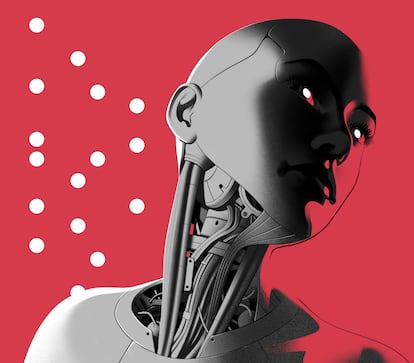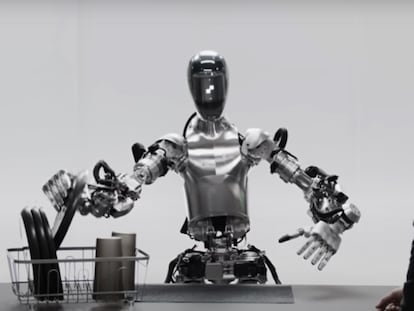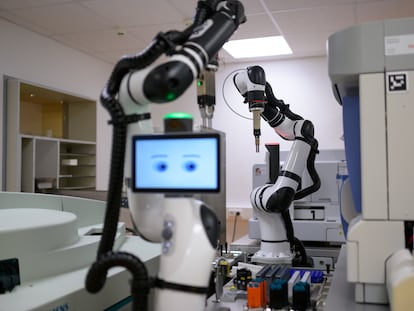The day robots were born
From a symbol of a hi-tech future to a household appliance, the image of the robot has undergone huge changes since its name was first used in a Czech play in 1921

Years ago the word robot suggested a technological future of humanoid mechanical servants who would work for us. Today, the word robot suggests free-roaming vacuum cleaners, and no need to look human. If we think about the origin of the term or its history, surely for many readers, the great proponent of science, biochemist, and science fiction writer Isaac Asimov springs to mind. The reality is that Asimov wrote a lot of literature about robots and it is to him that we owe the famous three laws of robotics: (1) a robot may not injure a human being... (2) a robot must obey the orders given to it by a human being (unless it conflicts with the first law), and (3) a robot must protect its own existence (unless it conflicts with the first or second law). These rules have been reformulated by different authors, but Asimov did not invent the term. The word robot predates the prolific Russian-born writer.
The concept of a robot was born on January 25, 1921 in Prague (Czechia). That night the play R.U.R., by Czech writer Karel Čapek, premiered. R.U.R. is the abbreviation of Rossum Universal Robots and that was the first time that anyone had heard the word in the sense that we give it today. Robot derives from the Czech term robota, which means “forced labor.” Curiously, the robots of RUR have nothing to do with C-3PO from Star Wars or with the Tin Man from The Wizard of Oz. They are not made of metal and electric circuits, but from a mass that is made in different mixing vats with a different formulation for each organ or part of the human body. The first robots that participated in a play looked quite human, something like the replicants in Blade Runner, which were indistinguishable from a human (except in the Turing test).
This first work on robots contains themes that would be taken up by many later authors. In the first act, a factory worker explains that these robots are created like humans, but everything that distracts them from their work has been removed. A human is imperfect and distracted, while a robot is the worker that any employer wants. Rossum, the inventor, announces that work is cheaper, thanks to his robots, and although people are made redundant, he has managed to recreate paradise with his invention for mankind, since humans will no longer need to work.
As expected, the play ends badly. The robots rebel against their masters and exterminate the entire human race (James Cameron did not invent anything new when Skynet became self-aware and started killing humans in The Terminator, nor did Arthur C. Clarke with HAL 9000 in 2001, A Space Odyssey). In the final dialogue, when the last of the humans turns to his robotic executioner and asks why he is doing it, he answers: “If you want to be like men, you have to kill and dominate. Read history! Read the books written by humans! If you want to be human, you have to kill and murder!” And that is the how humans meet their end. Let’s hope robot vacuum cleaners don’t follow the example.
It is still paradoxical that a word that we have adopted into everyday language and that we associate with technological advancement comes from a play that has an eminently technophobic message. The fear of technology is present in all cultures. In Greco-Roman culture we have the myth of Prometheus, who was punished for stealing fire from the gods. A few decades before Čapek, Mary Shelley had written Frankenstein, or The Modern Prometheus, which also exploited our fear of technology. Nor can it be said that R.U.R. came from nowhere. The influences of Jewish mythology in Prague are very evident. The whole story is reminiscent of the myth of the Golem, the clay man that a rabbi built to help him in his tasks but who ended up rebelling against him. Therefore, Čapek’s work is not exactly original, but his greatest contribution to culture was inventing a term that has become universal.
Circuitous terminology
— This whole story contains another curious tidbit. The word robot can also be translated from Czech as “slave.” The word slave, in many Latin or non-Latin languages (such as English), derives from the term meaning Slavic. When the play R.U.R. premiered, shortly after the First World War, Prague was the capital of Czechoslovakia. The names of Slovakia (and Slovenia) are also derived from the word “Slavic,” and Czech is a Slavic language. Therefore, slave comes from Slavic, and the term that defines slave in a Slavic language gives us the word robot. What a mind bender!
J. M. Mulet is a professor of Biotechnology.
Sign up for our weekly newsletter to get more English-language news coverage from EL PAÍS USA Edition
Tu suscripción se está usando en otro dispositivo
¿Quieres añadir otro usuario a tu suscripción?
Si continúas leyendo en este dispositivo, no se podrá leer en el otro.
FlechaTu suscripción se está usando en otro dispositivo y solo puedes acceder a EL PAÍS desde un dispositivo a la vez.
Si quieres compartir tu cuenta, cambia tu suscripción a la modalidad Premium, así podrás añadir otro usuario. Cada uno accederá con su propia cuenta de email, lo que os permitirá personalizar vuestra experiencia en EL PAÍS.
¿Tienes una suscripción de empresa? Accede aquí para contratar más cuentas.
En el caso de no saber quién está usando tu cuenta, te recomendamos cambiar tu contraseña aquí.
Si decides continuar compartiendo tu cuenta, este mensaje se mostrará en tu dispositivo y en el de la otra persona que está usando tu cuenta de forma indefinida, afectando a tu experiencia de lectura. Puedes consultar aquí los términos y condiciones de la suscripción digital.
More information
Archived In
Últimas noticias
Miguel Alandia, the artist whose murals were saved by miners under Bolivia’s military rule
What are men searching for (and running from) when they go on a retreat?
Why we lost the habit of sleeping in two segments and how that changed our sense of time
Meet Fly, the guardian of the hawksbill sea turtles on Santa Catalina Island
Most viewed
- The Florida Keys tourist paradise is besieged by immigration agents: ‘We’ve never seen anything like this’
- Liset Menéndez de la Prida, neuroscientist: ‘It’s not normal to constantly seek pleasure; it’s important to be bored, to be calm’
- December Social Security and SSI payments: Dates, double checks and the 2026 COLA increase
- The low-cost creative revolution: How technology is making art accessible to everyone
- Chevy Chase, the beloved comedian who was a monster off camera: ‘Not everyone hated him, just the people who’ve worked with him’










































